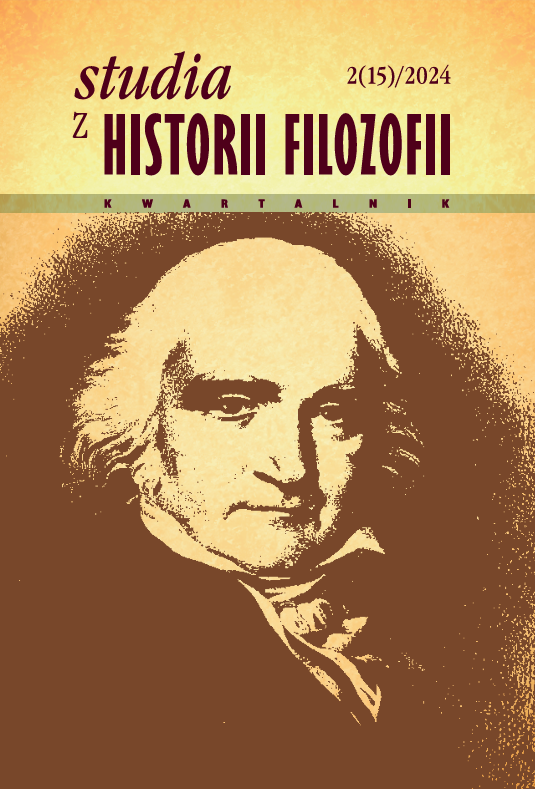Neoplatonizm i chrześcijaństwo w twórczości Synezjusza z Cyreny (370–414) – przyczynek do zagadnienia
DOI:
https://doi.org/10.12775/szhf.2024.009Schlagworte
Synesius, late antiquity, Christian Neoplatonism, Plotinus, patristicsAbstract
The article presents creative personality of Synesius of Cyrene (4th/5th century CE) against the background of ideological tendences of late antiquity. It aims to answer two questions: First, whether the term Christian Neoplatonism, rightly criticized in relation to patristic writers, reflect the nature of Synesius' outlook, and second, whether his work significantly complements our image of late antiquity in its philosophical aspect, viewed as a clash between Christian and classical, mainly Neoplatonic, philosophic paradigms. Synesius’ rich correspondence, consisting of one hundred and fifty-six letters, provides the main source for the present analysis; yet, his other works (mainly the Hymns) and biographical details are also drawn upon to attain a wholistic perspective. This broader selection of sources is necessary because a reading of his works leaves some doubt as to his ideological affiliation. On the one hand, he was a disciple of Hypatia, and, on the other, a friend of St. Theophi lus of Alexandria, who called him to the post of bishop. These and other ambiguities in the life and outlook of Synesius make him an interesting object of analysis.
Literaturhinweise
Bregman Jay. 1982. Synesius of Cyrene: Philosopher-Bishop. The Transformation of the Classical Heritage. Berkeley–Los Angeles–London: University of California Press.
Brown Peter. 1989. Society and the Holy in Late Antiquity. Berkeley: University of California Press.
Brown Peter. 1991. Świat późnego antyku, przeł. Anna Podzielna. Warszawa: Czytelnik.
Cameron Alan, Jacqueline Long. 1993. Barbarians and Politics at the Court of Arcadius. Berkeley–Oxford: University of California Press.
Cameron Averil. 2007. Późne cesarstwo rzymskie, przeł. Monika Kwiecień. Poznań: Prószyński i S-ka.
Chuvin Pierre. 2008. Ostatni poganie. Zanik wierzeń pogańskich w cesarstwie rzymskim od panowania Konstantyna do Justyniana, przeł. Joanna Stankiewicz-Prądzyńska. Warszawa: Czytelnik.
Clark Gillian. 2011. Late Antiquity: A Very Short Introduction. Oxford: Oxford University Press.
Crawford William S. 1901. Synesius the Hellene. London: Rivingstone.
Dimitrov Dimitar Y. 2008. „Synesius of Cyrene and the Christian Neoplatonism: Patterns of Religious and Cultural Symbiosis”. W: What Happened to the Ancient Library of Alexandria?, red. Mostafa El-Abbadi, Omnia Fathallah, 149–170. Leiden: Brill.
Heszen Agnieszka. 2019. Polihymnia chrześcijańska. Poetyka i morfologia greckich hymnów III–V wieku. Kraków: Wydawnictwo UJ.
Inge William R. 1926. The Platonic Tradition in English Religious Thought. The Hulsean Lectures at Cambridge 1925–1926. New York: Longmans, Green.
Jaeger Werner. 1997. Wczesne chrześcijaństwo i grecka Paideia, przeł. Krzysztof Bielawski. Bydgoszcz: Homini.
Johnson Scott F. 2012. The Oxford Handbook of Late Antiquity. Oxford: Oxford University Press.
Losiev Aleksej F. 2000. Istoria anticznoj estetiki, t. 8. Moskva: Folio.
Markus Donka. 2021. „Harmonizing Binaries: Hypatia’s Synesius”. The International Journal of the Platonic Tradition 15: 49–81.
Marrou Henri-Irénée. 1969. Historia wychowania w starożytności, przeł. Stanisław Łoś. Warszawa: PIW.
McEvoy James. 1995. „Neoplatonism and Christianity”. W: The Relationship between Neoplatonism and Christianity, red. Thomas Finan, Vincent Twomey, 155–170. Dublin: Four Courts Press.
Platon. 1987. Listy, przeł. Maria Maykowska. Warszawa: PWN.
lotyn. 1959. Enneady, t. 1–2, przeł. Adam Krokiewicz. Warszawa: PWN.
Rapp Claudia. 2005. Holy Bishops in Late Antiquity: The Nature of Christian Leadership in an Age of Transition. Berkeley–Los Angeles–London: University of California Press.
Rist John. 1996. „Plotinus and Christian Philosophy”. W: Cambridge Companions to Plotinus, red. Lloyd P. Gerson. Cambridge: Cambridge University Press.
Sheldon-Williams Inglis P. 1967. „The Greek Christian Platonist Tradition from the Cappadocians to Maximus and Eriugena”. W: The Cambridge History of Later Greek and Early Medieval Philosophy, red. Arthur H. Armstrong, 425–772. Cambridge: Cambridge University Press.
Sinko Tadeusz. 1959. Zarys historii literatury greckiej, t. 2. Warszawa: PWN.
Smith Andrew. 1991. Philosophy in Late Antiquity. London–New York: Routledge.
Starowieyski Marek. 1995. Muza chrześcijańska. Poezja grecka od II do XV wieku, t. 3. Kraków: Znak.
Swieżawski Stefan. 2000. Dzieje europejskiej filozofii klasycznej. Warszawa–Wrocław: Wydawnictwo Naukowe PWN.
Synésios de Cyrène. 1978. Hymnes, przeł. Christian Lacombrade. Paris: Les Belles Lettres.
Synésios de Cyrène. 2000. Correspondance, przeł. Denis Roques. Paris: Les Belles Lettres.
Synésios de Cyrène. 2004. Opuscules, przeł. Noël Aujoulat. Paris: Les Belles Lettres.
Synesius of Cyrene. 1926. Letters, przeł. Augustine Fitzgerald. Oxford: Oxford University Press.
Synezjusz z Cyreny. 1962. Pochwała łysiny, przeł. Leon Kotyński. Warszawa: PIW.
Synezjusz z Cyreny. 2015. O snach, przeł. Emilia Żybert. Wrocław: Atut.
Szymusiak Jan M. 1965. Grzegorz Teolog. U źródeł chrześcijańskiej myśli IV wieku. Poznań: Księgarnia św. Wojciecha.
Św. Ambroży. 2008. Mowa na śmierć Teodozjusza, przeł. Anna Kotłowska. Poznań: Wydawnictwo UAM.
Św. Augustyn. 1998. Państwo Boże, przeł. Władysław Kubicki. Kęty: Antyk.
Św. Augustyn. 2001. Dialogi filozoficzne. Kraków: Znak.
Św. Grzegorz z Nazjanzu. 1933. Listy, przeł. Jan Stahr. Poznań: Księgarnia Uniwersytecka.
Św. Grzegorz z Nyssy. 1974. „Dialog z siostrą Makryną o duszy i zmartwychwstaniu”, przeł. Wojciech Kania. W: św. Grzegorz z Nyssy, Wybór pism, 27–87. Warszawa: Wydawnictwo UKSW.
Św. Grzegorz z Nyssy. 2006. O naturze człowieka, przeł. Marta Przyszychowska. Kraków: WAM.
Św. Jan Chryzostom. 2000–2003. Homilie na Ewangelię według św. Mateusza, przeł. ks. Arkadiusz Baron, Elwira Buszewicz. Kraków: WAM.
Watts Edward J. 2015. The Final Pagan Generation. Oakland, CA: University of California Press.
Weiss Sonja. 2019. „The Net in the Sea: A Note to Plotinus’s En. IV 3(27).9.34–44”. Graeco-Latina Brunensia 24(2): 235–253.
Downloads
Veröffentlicht
Zitationsvorschlag
Ausgabe
Rubrik
Lizenz

Dieses Werk steht unter der Lizenz Creative Commons Namensnennung - Keine Bearbeitungen 4.0 International.
Stats
Number of views and downloads: 462
Number of citations: 0



